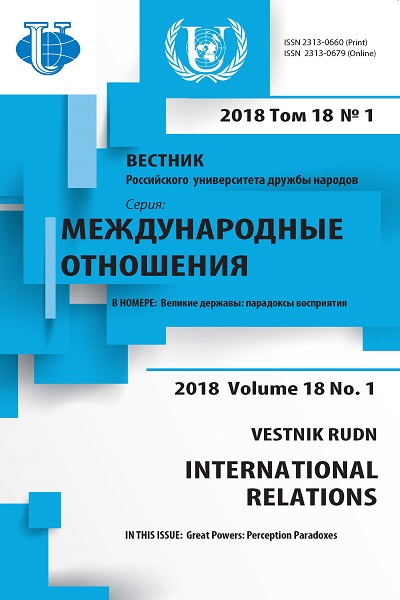The AIIB, multilateral and national development banks: potential for cooperation
- Authors: Shelepov A.V.1
-
Affiliations:
- Russian Presidential Academy of National Economy and Public Administration
- Issue: Vol 18, No 1 (2018): Great Powers: Perception Paradoxes
- Pages: 135-147
- Section: INTERNATIONAL ECONOMIC RELATIONS
- URL: https://journals.rudn.ru/international-relations/article/view/18382
- DOI: https://doi.org/10.22363/2313-0660-2018-18-1-135-147
Cite item
Full Text
Abstract
This article focuses on one of the new multilateral development banks (MDBs) dominated by emerging economies - Asian Infrastructure Investment Bank (AIIB). The creation of this institution was stimulated, inter alia, by the growing demand for infrastructure financing. However, in most cases MDBs cannot finance large infrastructure projects without pooling their resources. To better understand the AIIB prospects in addressing infrastructure investment gap, this article analyzes the existing formats of its cooperation with other MDBs and co-financing mechanisms they use, and outlines possible directions for further cooperation. The author explores memoranda of understanding between the AIIB and other MDBs, examines practical aspects of engagement and makes a projection regarding their joint financial contribution growth in the coming years. The forecast includes two scenarios: basic and optimistic, and is based on the analysis of AIIB existing partnerships with other institutions and volumes of financing for joint projects. The methodology used for assessment takes into account potential developments in the bank in terms of capital growth, membership expansion and attracting resources in the financial market. Based on the forecast, the author concludes that in five years the new bank together with its partners will be able to provide infrastructure financing of up to US$ 165 billion. In order to develop cooperation in accordance with the optimistic scenario, the AIIB should start relying on its own environmental and social practices, acting as a main co-financier. However, the potential of AIIB interaction with national development banks that can also contribute to better infrastructure financing is currently underutilized. This article shows that in future, cooperation in this area can become a significant component of increasing the AIIB’s contribution to narrowing the global infrastructure gap.
About the authors
Andrei Vladimirovich Shelepov
Russian Presidential Academy of National Economy and Public Administration
Email: shelepov-av@ranepa.ru
research fellow of the Research Center of International Institutes of the Russian Presidential Academy of National Economy and Public Administration
References
- Armendariz de Aghion, B. (1999). Development Banking. Journal of Development Economics, 58. URL: http://citeseerx.ist.psu.edu/viewdoc/download?doi=10.1.1.177.4329&rep=rep1&type=pdf. (accessed: 30.10.2017)
- Bhargava, V. (2006). Global Issues for Global Citizens: An Introduction to Key Development Challenges. Washington, DC: World Bank
- Bhattacharyay, B.N. (2010). Estimating Demand for Infrastructure in Energy, Transport, Telecommunications, Water and Sanitation in Asia and the Pacific: 2010-2020. ADBI Working Paper Series, 248. URL: https://openaccess.adb.org/handle/11540/3836 (accessed: 30.10.2017)
- Bruck, N. (1998). The Role of Development Banks in the Twenty-First Century. Journal of Emerging Markets, 3, 39-67. URL: http://www.adfiap.org/wp-content/uploads/2009/10/the-role-of-development-banks-in-the-twenty-first-century.pdf (accessed: 30.10.2017)
- Center for Global Development (2016). Multilateral Development Banking for This Century’s Development Challenges. URL: https://www.cgdev.org/sites/default/files/multilateral-development-banking-report-five-recommendations.pdf (accessed: 30.10.2017)
- Development Committee (2015). From Billions to Trillions: Transforming Development Finance. Post-2015 Financing for Development: Multilateral Development Finance. URL: http://siteresources.worldbank.org/DEVCOMMINT/Documentation/23659446/DC2015-0002(E)FinancingforDevelopment.pdf (accessed: 30.10.2017)
- Faure, R. et al. (2015). Multilateral development banks: a short guide. ODI. URL: https://www.odi.org/ sites/odi.org.uk/files/resource-documents/10650.pdf (accessed: 30.10.2017)
- Humphrey, C. (2015). Developmental revolution or Bretton Woods revisited? ODI Working paper 418. URL: https://www.odi.org/sites/odi.org.uk/files/odi-assets/publications-opinion-files/9615.pdf (accessed: 30.10.2017)
- Larionova, M. V. & Shelepov, A. V. (2016). Potential role of the NDB and AIIB in the global financial system. Vestnik RUDN. International Relations, 16(4), 700-716. doi: 10.22363/2313-0660-2016-16-4-700-716
- Shelepov, A.V. (2016). Comparative Prospects of the New Development Bank and Asian Infrastructure Investment Bank. International Organisations Research Journal, 11 (3), 132-152. doi: 10.17323/1996-7845-2016-03-132
- Shelepov, A.V. (2017) New and Traditional Multilateral Development Banks: Current and Potential Cooperation. International Organisations Research Journal, 12 (1), 127-147. doi: 10.17323/1996-7845-2017-01-127
- Snell, S. (2015). China’s Development Finance: Outbound, Inbound, and Future Trends in Financial Statecraft. U.S. - China Economic, and Security Review Commission (USCC). URL: https://www.uscc.gov/sites/default/files/Research/China’s%20Development%20Finance.pdf (accessed: 30.10.2017)











